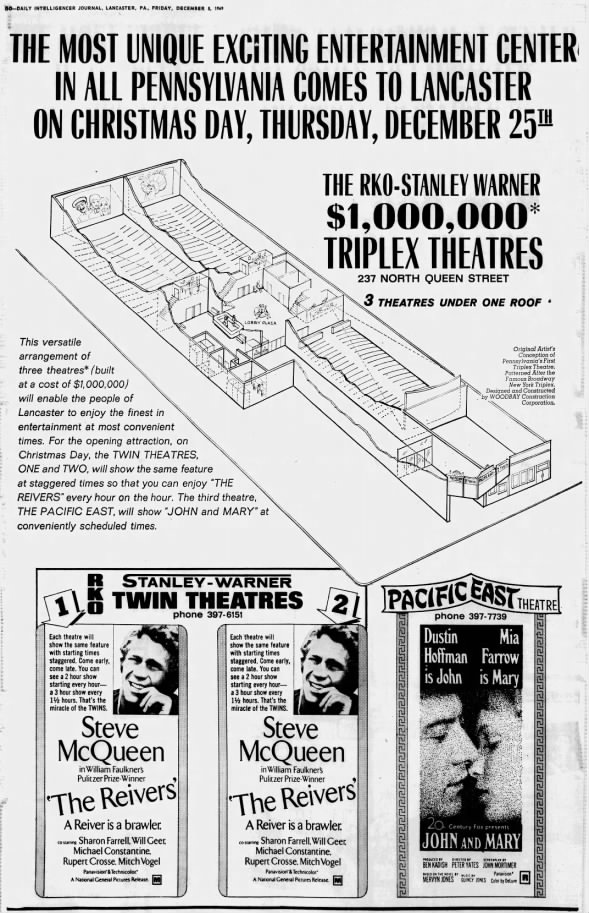
United Artists Pacific 4
237 N. Queen Street,
Lancaster,
PA
17603
237 N. Queen Street,
Lancaster,
PA
17603
![]() 1 person
favorited this theater
1 person
favorited this theater
Showing 5 comments
This opened on Christmas Day, 1969. Twin theatres and Pacific East Opening Fri, Dec 5, 1969 – 50 · Intelligencer Journal (Lancaster, Pennsylvania) · Newspapers.com
Twin theatres and Pacific East Opening Fri, Dec 5, 1969 – 50 · Intelligencer Journal (Lancaster, Pennsylvania) · Newspapers.com
Did it get its name because Pacific theatres from
Los Angeles had an internist with RKO S.W.?
When I moved to Lancaster (just out of college circa the early ‘60s) the Hamilton was closed. I was always fascinated by it. Any comments?
As I remember the entrance was set back from the street in a kind of arcade. I assumed it had once been an old legitimate theater?
As I have written elsewhere I lived at 123 N. Queen St. (a few doors down from the Grand) during the early stages of the demolition. It was like living in a war zone.
Hope you’ll add more about Lancaster theaters.
When this “theatre” opened it was called the RKO Twin and Pacific East Cinema. The twins were the two theatres that faced each other on the right side of the building. The Pacific East Cinema was on the left side of the building by itself. It was a typical RKO constructed theatre. As the manager told me, they used the cheapest theatre seats available. The lobby as mentioned above had the red flocked wallpaper mixed with large panes of smoked glass. The lobby lights were flourescent with colored plexiglass panels. It certainly was no replacement for the large original movie palaces located in the 200 block of North Queen Street. I was an assistant
manager here from Sept. 1970 until May 1971. As much as I liked movies, I could see there was no future in theatre management. The manager that I worked for had worked for Stanley Warner and then RKO Stanley Warner for a long time. He was the manager of the Capitol Theatre that was torn down in the next block. I knew what he was getting paid and it would not have been a livable wage for someone just starting out in the working world. Granted this was 40 years ago, but my starting pay as an assistant was $75.00 a week. In addition to the fact that I worked five nights a week. I was off on Sunday nights after working the Sunday matinees, Monday was my day off, and I went back to work Tuesday evening. Then for the rest of the week worked during the day, had two hours off around supper time, and then went back to work for the rest of the evening. Stanley Warner operated three of the four theatres that were torn down – The Capital, The Hamilton, and the Grand. I do not remember the Hamilton being opened as a theatre. When I was growing up the lobby was used as a bar and then that closed. One of these days, I am going to add some comments on the other theatres threads. I have been telling myself that since they were listed. However, I want to go through my local history books and newspaper articles from when the theatres were demolished to get my facts straight before doing that. Someday……
Actually the Eric Twins down the street showed the China Syndrome. I saw it there. The flocked red paper and the crackly-gold mirrors reminded me of a cat-house, too.
The Eric Pacific 3 was on the third block of N. Queen St. in downtown Lancaster, Pennsylvania. The second block of N. Queen St. included four classic movie houses, some of which had histories as legitimate and vaudeville theaters. (None of them seem to be included among the Cinema Treasures listings).
The entire second block (including the huge old Brunswick Hotel) was torn down sometime in the 1960s. The Pacific 3 aka (as I recall) the Pacific East, replaced the vintage theaters which had been so cruelly and foolishly destroyed. As the photo (link) shows there was no real style to the new theater though the interior had that scarlet red flocked wallpaper that made it seem you were walking into a Chinese bordello. (This was a generic look which could be found in theaters of the same period almost anywhere, including the east side of New York City).
During the Three Mile Island nuclear accident the Pacific East showed, very ironically, THE CHINA SYNDROME!